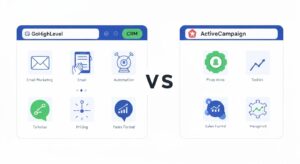The Compounding Effect of Client Data: How Agencies Can Scale Smarter

A lot of groups gather info but don’t use it’s power. They get leads from many places, keep an eye on campaigns, and keep track of all the times they’ve talked to clients. But this information is often spread out, not constant, or just idle. Often, the difference between agencies that stay the same and ones that grow regularly is how well they use their data.
As time goes on, a good agency CRM data strategy turns standard data into benefits that keep getting better. When government agencies combine, organize, and use data in a smart way, they stop guessing and make long-term decisions that are correct. Over time, this creates a strong feedback loop: better targeting leads to more conversions, more conversions lead to more insights, and those insights make future efforts even more successful.
We’re not just getting more info for the sake of it with this method. Making a system that turns raw materials into long-term value is important for both short-term wins and long-term growth.
Scattered Data: A Hidden Growth Blocker
Data is often kept separate in many places. Different teams use different tools for reports and keep track of leads in different files. Emails are used to hide talks with clients. It might not seem like a problem at first that these different sources are separate, but they cause problems that slowly drain earned income.
When teams don’t agree on what the client looks like, campaigns stop being planned and become more hurried. Important clues are lost because they can’t be seen at the right time. These could be changes in how leads act, contact trends, or data on past purchases. During reporting talks, people spend a lot of time adding up numbers instead of talking about how things are going.
It’s also bad for business ties when people break up. If the data isn’t organized, account managers could miss important details, like a recent question that wasn’t answered or a key milestone that wasn’t properly marked. This kind of mistake can make people less likely to trust you and stay a client over time.
All of this information is put into one well-organized system by a good CRM plan. This gets rid of these issues. This way, the right people can see it at the right time.
Centralizing Data Through CRM
Every agency’s data plan should be based on a single reliable source of truth. Because it keeps track of leads, talks, campaigns, and deals all in one place, a customer relationship management (CRM) tool is the base.
Teams should keep track of all of their contacts so that they don’t have to rely on their memories or notes that are all over the place. Marketing can see what’s going on in sales. Before handing off, account managers can look over how engaged prospects are. Instead of waiting for reports to be made by hand, leaders can see how healthy the system is and how well the campaign is doing.
Centralization is not just about convenience. It fundamentally changes how agencies operate. Decision-making becomes evidence-based. Opportunities are spotted earlier because data is no longer buried in disconnected tools. And because the information is structured, automations can act on it in real time, accelerating response times and improving accuracy.
A single source of truth also builds confidence. Teams know that the numbers they see are the same across the organization. That level of clarity gets rid of misunderstandings and lets everyone focus on getting things done instead of trying to make peace
Turning Data Into Actionable Insights
It’s easy to gather info, but the real power comes from knowing how to use it well. The goal of a good agency CRM data strategy is to turn data into ideas that can be used to make money.
For instance, agents can find out which strategies regularly bring in quality leads by looking at lead sources over time. By keeping track of how people interact with emails, texts, and phone calls, you can see where the sales process is getting stuck. Looking at past trends of client retention can help you figure out if a customer will repeat or leave.
Once these trends are clear, agencies can make very precise changes to their plans. Marketing funds can be put toward the platforms that work best. To close deals faster, follow-up steps can be made better. Account managers can step in before a relationship with a client starts to get tense.
It’s not how much data there is that matters, but how it is organized and what it means. When data is organized in the CRM, it’s easier to run reports, see trends, and set up automations that act in smart ways. This makes a cycle where every action leads to new insights, which in turn lead to smarter choices, which in turn lead to better results.
Data Hygiene: The Unsung Hero of Scalability
You can only use a CRM system that is as good as the information it stores. A lot of organizations don’t realize how much bad info hurts their plans. Name patterns that don’t match, fields that aren’t full, and records that are out of date cause problems at every step.
When data cleaning isn’t taken care of, the truth of reports suffers. Automations go off at the wrong time. Teams waste time cleaning up data by hand instead of using that time to do something useful. Over time, this makes people less likely to believe the system, and they go back to keeping their own files, which defeats the point of standardization.
Data cleaning isn’t something you do once and are done with; it’s something you do all the time. Setting clear rules for data entry, auditing records on a regular basis, and teaching teams to follow these rules all help agencies in the long run. Clean data makes it easy for the CRM to work, helps with accurate reporting, and drives automations that always do their job.
This task may not seem as exciting as launching a campaign or putting new technology into use, but it’s what makes everything else run easily.
Scaling Smarter with Feedback Loops
One of the best things about a data plan based on CRM is that it lets you set up feedback loops that improve performance over time. Every contact with a campaign that runs through a central system creates data that can be used to make decisions. This data is used to improve strategy, so each new project is better prepared than the last.
For example, sales trends can give us ideas for how to write future messages. How training processes are set up can be affected by retention data. Which automation events have the biggest effect can be based on how the lead acts. Instead of starting from scratch for each client or campaign, companies learn from what works and make changes based on that.
This method of ongoing improvement doesn’t need huge steps forward. When small changes are made over and over, they add up to big performance gains. Over the course of months and years, the agency’s data strategy grows like interest, giving huge returns on what started out as small changes to how things are run.
Strategic Alignment
Agencies should make sure that their CRM strategy and their attempts to track success are in sync for data to really work for them. Managing organized data and having clear income measures together is a good way to do this. When agencies use their CRM to keep an eye on the right measures, they get the clarity they need to act on insights instead of just watching them. This connection makes it possible for raw data to lead to real growth.

Conclusion
Client and lead data has a lot of promise, but it’s not being used because there is no plan. When agencies invest in an organized, well-thought-out approach, they start a chain reaction that leads to better decisions, more effective campaigns, and stronger relationships with clients.
A good company A CRM data plan doesn’t need a lot of people or complicated technology. For this to work, groups need to be well-organized, follow the rules, and make good use of the information they already have. All of an agency’s data should be kept in one place, and feedback loops should be set up to help them improve their strategies over time. This will help the agency grow in a way that lasts.
It’s not always the agencies with the most data that can grow the fastest. Sometimes it’s the agencies that know how to use the data. In the long run, rivals will find it very hard to beat this edge.







